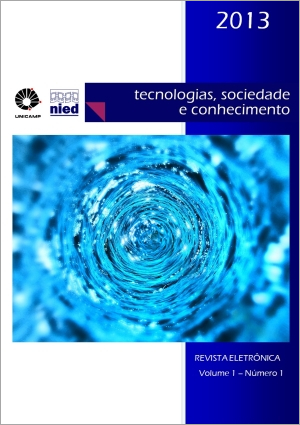Resumo
Programming is many things to many people, and not everyone agrees on its potential for human learning. This is especially true at a time when ever younger children are increasingly “expert” gamers, tweeters, information-seekers, and digital “bricoleurs”. Often self-taught, or at least grabbing much of what they know or are interested in) outside the classroom, today’s youngsters indeed surprise—and on occasion surpass us—with their clever uses of all things digital. Question is: how much of this “expertise” is deemed sufficient by experts in the field? This paper looks at programming “obliquely,” as an opportunity to explore issues of agency, control, and interaction styles, as played out in the creative and critical uses of “smart” tools by curious minds.
Referências
ACKERMANN, E. The Agency model of transaction. In: HAREL, I.; PAPERT, S. (Eds.). Constructionism. Norwood, NJ: Ablex Publishing Company, 1991. p. 367-379
ACKERMANN, E. Enactive representations in learning: Pretense, models, machines. BLISS, J.; LIHGHT, P.; SALJO, R. (Eds.). Learning Sites: Social and technological Contexts for learning. Oxford: Pergamon/Elsevier, Advances in learning and Instruction.1999. p. 144-154.
ACKERMANN. E. Relating to things that think: Animated toys, Artificial creatures, Avatars. Play of Ideas and ideais of Play. I3 Magazine: The European network for intelligent information interfaces. v. 8, p. 2-5, jul. 2000.
ACKERMANN, E. Playthings that do things: A young kid’s “incredibles”!. Interaction Design and Children. IDC 2005, Boulder, Colorado, USA, June 8-10, 2005. Disponível em: http://web.media.mit.edu/~edith/publications/2005-playthings.pdf. Acesso em: novembro 2013.
ACKERMANN, E. Minds in motion, Media in transition: Growingup in the digital age. Areas of change. Child Research Net. Japan, 2011. Disponível em: http://www.childresearch.net/papers/digital/2011_01.html. Acesso em: novembro 2013.
ANNANY, M. Teel-Tale. 2001. Tese (Doutorado). The MIT Media Lab. Cambridge, MA, 2001.
BRANDES, A. Children’s ideas about machines. Paper presented at the annual meeting of the American Educational Research Association. 1992.
CAREY, S. Conceptual Change in Childhood. Cambridge: MIT Press, 1985.
DE LOACHE, J.; UTTAL, D.; PIERROUTSAKOS, S. Waiting to use a symbol. In: DEMETRIOU, A. (Ed.) Cognitive Development: New trends and questions. Special Issue of Learning and Instruction. 1998. v. 8. 4, p. 325-341.
EISENBERG, M.; BUECHLEY, L. Children’s programming, reconsidered: Setting, stuff, and surfaces. Proceedings IDC 2009, June 3–5, Como, Italy: Copyright 2009 ACM 978-1-60558-395-2/09/06.
NAGAKI, K.; HATANO, G. Young children's spontaneous personification as analogy. Child Development, v 58, n. 4, p. 1013-20, 1987.
LAKOFF, G.; JOHNSON, M. Metaphors We Live By. Chicago: Chicago University Press, 1981.
PAPERT, S. Mindstorms: Children computers and powerful ideas. New York: Basic Books, 1980.
RESNICK, M. Turtles, Termites, and Traffic Jams: Explorations in massively parallel microworlds. Cambridge, MA: MIT Press, 1990.
RUSHKOFF, D. Program or be Programmed: Ten Commands for a digital Age. 2010. Disponível em: http://www.youtube.com/watch?v=imV3pPIUy1k. Acesso em: novembro 2013.
STEWARD, J. Perception of animacy. 1982. Tese (Doutorado). University of Pennsylvania, 1982.
TURKLE, S. The Second Self. New York: Simon & Schuster, 1984.

Este trabalho está licenciado sob uma licença Creative Commons Attribution 4.0 International License.
Copyright (c) 2013 Tecnologias, Sociedade e Conhecimento

